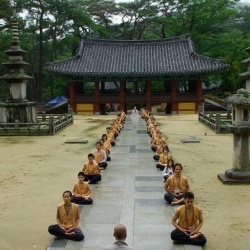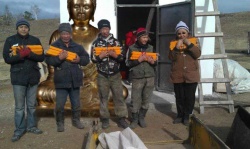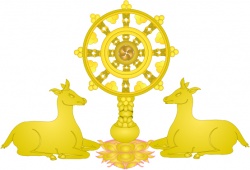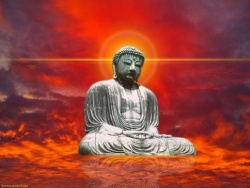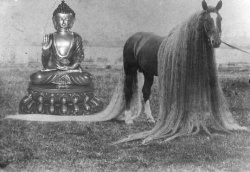Samadhi and Anuloma
- Samadhi means fixing the mind upon an object, concentration, and Anuloma means following the grain, conformity, and is also used in the sense of gathering samadhi in the initial stages of vipassana development and later in the beginning of the path process (Anuloma-nana, knowledge of adaptation).
Samadhi itself creates no problems of misunderstanding, it is a skill, and the more a meditator practices the more skilful they become.
However, the results of samadhi, particularly as described in some Buddhist texts, are often misleading, namely when connected to the development of jhana.
This is because the term jhana itself is not well described, and apart from a few references, the purer forms of jhana, lokuttara jhanas, are hardly mentioned or specified.
Thus, some scholastic interpretations of the purer jhanas are merely speculative extensions of ordinary jhanas.
Therefore, there needs to be the recognition that some jhanas are mundane, lokiya, and that some are supramundane, lokuttara, and that what is developed is dependent upon the condition of the mind of the meditator, i.e. ordinary people develop mundane jhanas and those with path knowledges (yahn) develop supramundane jhanas.
One obvious difference between mundane and supramundane jhanas is that supramundane jhanas do not result in the same absorption as mundane jhanas, because their foundation is different, i.e. path knowledge in the case of supramundane jhanas and the five aggregates in the case of mundane jhanas.
It is also said that supramundane jhanas can be developed while moving, or even talking (except for Nirodha Samapatti), which is not the case for mundane jhanas.
Supramundane jhanas develop pannya (sine, samadhi, pannya) and while the pannya, or increased awareness, changes consciousness, it is not rebirth into yet another realm of samsara.
This development of pannya is also said to be extremely blissful, and path knowledge meditators prior to Anagamis in particular are said to be quite adept at ‘blissing out’.
Regarding samadhi, some scholars have inferred that those yogis who do not initially develop jhanas and become ‘dry insight’ meditators will perhaps have inferior samadhi.
However, for most meditators, this is not really an issue as many people develop jhanas quite easily, and quite a few novices and lay people develop fourth jhana.
Additionally, although samadhi is not wilful in the more direct form of vipassana development (following the breath with the rising and falling of the abdomen) as it is balanced by sati, mindfulness, samadhi often becomes stronger than sati, particularly if the meditator sits for too long, resulting in jhana.
While some Buddhist texts do mention that The Buddha emphasized the development of jhana, one would think that this was either aimed at beginning meditators, as most of his senior students were already completely adept in developing jhanas, or that the jhana he was referring to was actually supramundane jhana and the development of pannya.
As for the overall scope of samadhi, it is said that the development of mundane jhanas is equivalent to learning to crawl, and the development of the initial path knowledges and supramundane jhanas as equivalent to learning to walk.
This is because the 'diving' technique used with path knowledges is said to lend itself to the use of the energy of the mind, something not possible to the same extent in basic anapanasati, thus samadhi can become even more wilful and forceful in the development of supramundane jhanas.
Once a yogi reaches the level of Anagami, it is said that as there are no longer any concerns with being mindful of attachment to pleasing and unpleasing contacts in the mind, the strength of anuloma increases and samadhi increases in energy even more, resulting in powerful samadhi.
This level is said to increase even further when the yogi becomes fully aware, becomes an Arahant, and irrespective of the way they began, all Arahants have powerful samadhi.
This illustrates the obvious, that there are different levels of samadhi, and while the development of mundane jhanas signifies good samadhi, in real terms, however, supramundane samadhi is simply inconceivable to ordinary minds.
On further point mentioned in texts regarding Nirodha Samapatti, the highest supramundane jhana, is that it is explained as nirhode, cessation of consciousness, or bhavanga, which does not represent an accurate description.
The idea that someone would spend their whole life developing vipassana just so that they could experience a state of mind that they could also experience by falling asleep is simply an example of applied speculation on the part of scholars.
Nirhode, here, means the cessation of all sankhara, mental states, namely nirvana.
It is said that Nirodha Samapatti (Buddhachahn, Thai) results in the cessation of all physical feeling, the eyes open slightly, as depicted in Thai Buddha images, and both mind and body are in nirvana.
The yogi, however, maintains full awareness, hearing and sight still operate, although sight is limited to an awareness of the light coming in through the almost closed eyes.
The sense of smell does not operate because the yogi is not breathing.
Regarding anuloma in the broad sense of conformity, then becoming a member of The Sangha and leading the homeless life is an obvious advantage in the development of vipassana samadhi.
This is, however, providing that the ‘homeless life’ is correctly understood.
It not only means living away from home and letting go of the usual domestic activities, but also means letting go of the usual social contacts that people have. Understandably, some people may wish to remain in contact with relatives and close friends.
However, this presents some problems and has to be balanced accordingly.
While many people may perhaps wish to be able to send postcards from nirvana, the person who is most likely to experience nirvana will do so without any frequent contacts with friends or relatives.
The reason being that friends fix the person, the personality, the self, and trying to go step by step in a new direction while taking backward steps at the same time means that progress will be difficult.
Members of The Sangha and those developing vipassana need only one good friend, and that is the Ajarn.
With parents, this requires some polite balancing, and postcards (even if not from nirvana) are ideal; keeping actual contacts to a bare minimum, for several years at least.
The person who develops in vipassana meditation is not the same person who began this development, and with long periods of effort and perseverance there will be no person remaining (in the usual sense).
The Vinaya, discipline, is also a broad example of anuloma, going with the grain.
However, in more recent times it has been used as a means of conforming to the views of society and becoming regarded as highly disciplined and virtuous, rather than a means of conforming to the development of vipassana samadhi and becoming a noble being. The two aims are not the same, and neither are the results.
The results of silabatta paramasa, clinging to rites, ceremonies, and virtue, can be seen in the history of The Sangha, where some members had such wrong view (micchaditthi) that they came to hate the real Dhamma.
Genuine people, as in the sense of pure, are hard to find, somewhat like genuine Thai honey.
In Thailand, the natural forest honey is created by large wild bees, and once collected is usually mixed with sugar water and sold in the market as pure honey.
The people who buy this honey come to accept this mixture as genuine honey, and later, if they do ever have the opportunity to taste real honey, they usually consider that it is not genuine, not pure.
The moral of this analogy being, as with pure honey, do not go looking for pure Dhamma in the marketplace.
In the complete analysis, anuloma is concerned with the gathering and development of samadhi, which may not quite be the most important aspect of Buddhism, which we reserve for basic morality, but it is certainly close behind.
Right samadhi, balanced by sati, mindfulness, is the source of pannya, and without the continuous development of samadhi it is impossible to progress in Buddhism.
In today's world, it is common for many people to think that they cannot develop in what appears to be an esoteric and demanding pursuit.
However, this is merely the 'thinking, thinking' that goes with being sophisticated and living a modern lifestyle.
We could correctly say that someone has very little chance if there are no longer any teachers and Ajarns available for guidance. However, this is not the case.
Therefore, the possibilities are there for those who are able to see beyond their thinking, which changes from moment to moment, and simply proceed by doing it.


